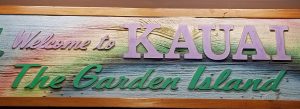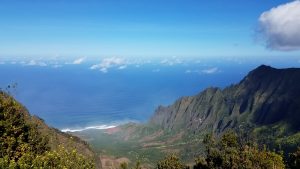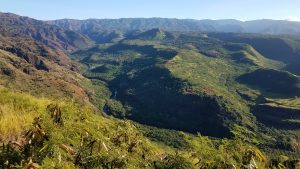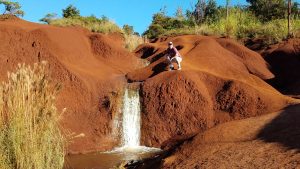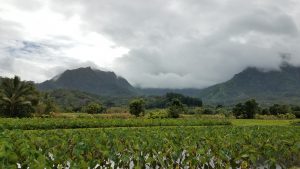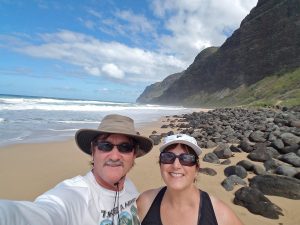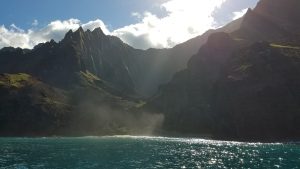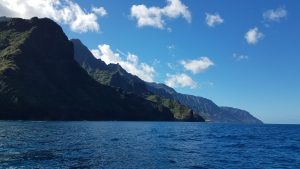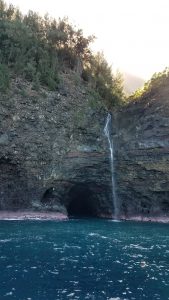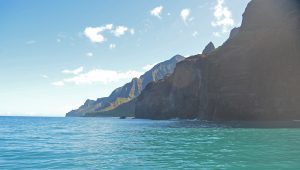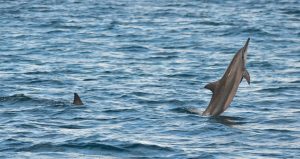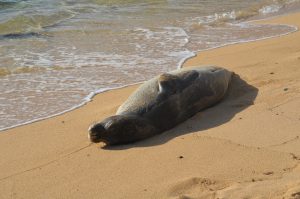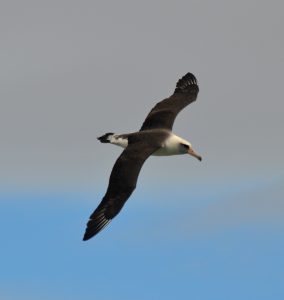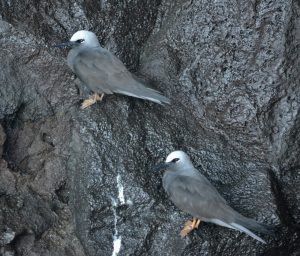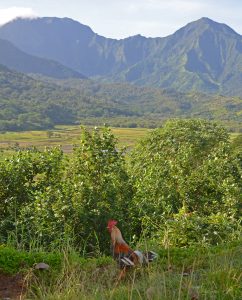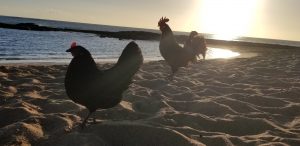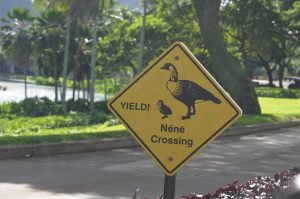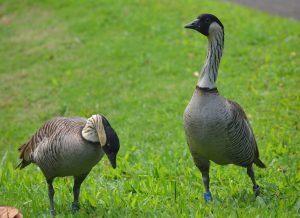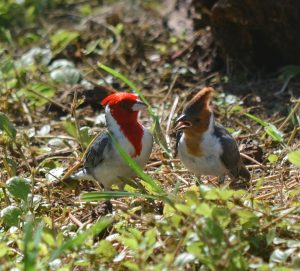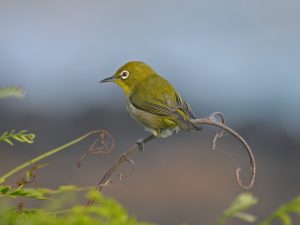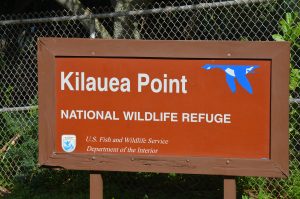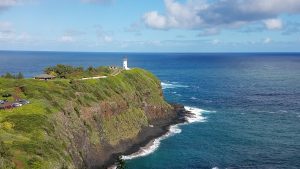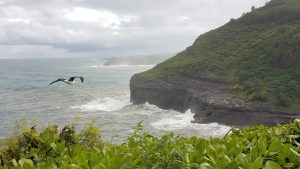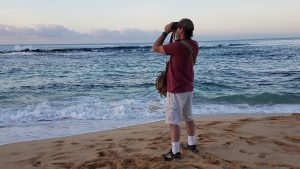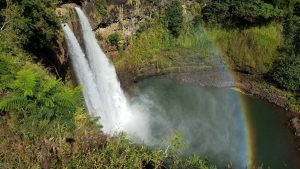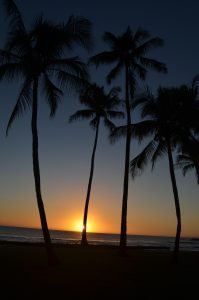We all have our own definition of paradise, or a place where we have visited we may consider paradise. One of Webster’s Dictionary defines paradise as “a state of bliss, felicity, or delight.” Oh, and if you’re not sure exactly what “felicity” means, it means happiness. So, by definition, paradise is any place you feel happy! For me, I have a lot of paradises! Recently, Theresa and I had the opportunity to visit one such paradise-the island of Kauai, in Hawaii.
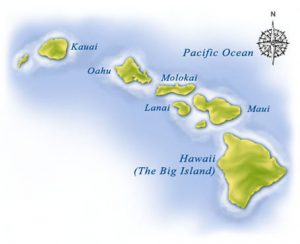 Like the other Hawaiian Islands, Kauai’s climate is tropical, with generally humid and stable conditions year round. Daytime temps don’t vary much throughout the year, averaging about 78 degrees F in February, to 85 degrees F in August. It was the lure of these sunny days, beautiful beaches and warm water to swim, snorkel and surf (sorry, not me) that attracted us to Hawaii to celebrate our 30th anniversary and temporarily escape the cold, snowy weather of Virginia in late November/early December. But, why Kauai, compared to the more well-known islands of Oahu, Maui or the “big island” of Hawaii? As a bit more adventurous, we wanted something more than your average beach vacation, and with Kauai’s dramatic landscape beauty, we found it!
Like the other Hawaiian Islands, Kauai’s climate is tropical, with generally humid and stable conditions year round. Daytime temps don’t vary much throughout the year, averaging about 78 degrees F in February, to 85 degrees F in August. It was the lure of these sunny days, beautiful beaches and warm water to swim, snorkel and surf (sorry, not me) that attracted us to Hawaii to celebrate our 30th anniversary and temporarily escape the cold, snowy weather of Virginia in late November/early December. But, why Kauai, compared to the more well-known islands of Oahu, Maui or the “big island” of Hawaii? As a bit more adventurous, we wanted something more than your average beach vacation, and with Kauai’s dramatic landscape beauty, we found it!
Known locally as the “Garden Island,” Kauai is the oldest (approximately 5 million years old) and northernmost island in the Hawaiian chain. Although it only covers a total area of about 532 square miles (about 1/3 the size of our smallest state, Rhode Island), it’s volcanic origin has created emerald valleys, sharp mountain spires and jagged cliffs aged by time and the elements. Centuries of growth have formed tropical rainforests, forking rivers and cascading waterfalls! The highest peak on this mountainous island is Kawaikini at 5,243 feet. This area is renowned for being one of the wettest spots on earth, receiving over 450 inches of rain each year. The high annual rainfall has eroded deep valleys in the central mountains, carving out canyons with many scenic waterfalls. On the west side of the island is the Waimea River whose flow formed Waimea Canyon, one of the world’s most scenic canyons, which is part of Waimea Canyon State Park. At 3,000 ft. deep, Waimea Canyon is often referred to as “The Grand Canyon of the Pacific.” On one of our day trips up through the canyon, we drove our rental vehicle up a very steep, windy road with no guide rail. Although around every curve there seemed to be a perfect photo stop, Theresa politely, and a bit nervously, reminded me to keep my eyes on the road! She did not want to experience another scary close call like we had in California a few years ago-known in our family as the “Death Valley Incident of 2015!” On that infamous hot afternoon in May, one of the front tires of the car I was driving (Theresa’s side) accidentally slipped off the pavement of a really steep road (again with no guide rail) we were driving up. It was a pretty dangerous 500’ drop off, on the edge of a rocky cliff. To this day, the details are still blurry to me, but my wife and daughter insisted my eyes, and steering wheel, turned slightly to the right when a bird flew across the road right in front of us. They didn’t seem to care, when, after re-gaining my own composure, I told them it was a cool-looking Rock Wren! They didn’t speak to me for an hour. The road up through Waimea Canyon was much the same. However, I think we were sold on this destination when we saw photos/video about the canyon and the wild and scenic Na Pali Coast.
Waimea Canyon State Park (top-left & right and bottom left, taro fields-bottom right)
If you’ve ever watched any of the following movies: Jurassic Park (1993), Raiders of the Lost Ark (1981), King Kong (1976), Pirates of the Carribean-On Stranger Tides (2011), Six Days Seven Nights (1997), Tropic Thunder (2007) or a dozen others, then you’ve seen parts of the Na Pali Coast of Kauai. I’m pretty sure I saw a velociraptor running along one of the remote beaches! The pali, or cliffs, provide a rugged backdrop of deep, narrow valleys ending abruptly at the sea. Waterfalls and swift flowing streams continue to cut these narrow valleys while the sea carves cliffs and caves at their mouths. Extensive stone walled terraces can still be found on the valley bottoms where Hawaiians once lived and cultivated taro. Over the years, there were a few places we’ve visited that no matter how many photos and/or videos you take, they just couldn’t capture the true essence of experiencing them in person. The Na Pali Coast of Kauai is absolutely one of them! If you can, you gotta see this place!
Above-Theresa and I at Polihale State Park, and the beautiful Na Pali Coast of Kauai
Along with the gorgeous landscapes, the clear blue waters that surround Kauai also hold a rich variety of natural treasures teeming with marine life. Colorful fish inhabit the striking coral reefs, while Green Sea Turtles forage along the coast for sea grass and jellyfish, as well as using the many unspoiled beaches to lay their eggs. In the winter months Humpback Whales share these warm waters with pods of Spinner Dolphins and the endangered Hawaiian Monk Seal. From the many rock cliffs, an assortment of sea birds such as Brown and Red-footed Boobies, White-tailed and Red-tailed Tropicbirds, Great Frigatebirds, Laysan Albatrosses and several Petrels and Shearwaters, soar for hours on trade winds in search of fish. And wild birds aren’t the only birds that inhabit Kauai.
Above-Spinner Dolphins (left) and the endangered Hawaiian Monk Seal taking a nap (right)
Below-Green Sea Turtle (left), Laysan Albatross (center), Black Noddys (right)
From the minute we stepped out of the airport in Lihue, we encountered our first Hawaiian animals. Notice I didn’t say wildlife. Nope, they were chickens, or moa, in Hawaiian. They’re pretty much everywhere, from rural areas to downtown streets and suburban neighborhoods. We saw them in local parks, shopping centers, beaches and golf courses, and yes, crossing just about every road. Why? Because they own many of the roads! The only places we really didn’t see them were around any KFC and the local Chicken-In-A-Barrel restaurants! The roosters crow every day-of course early every morning, but also mid-day, and sometimes at night. They really don’t care when, they just keep roostering! Historians say the fowl were brought to Kauai by the Polynesians as a source of food, thriving on an island where they have no real predators. Most locals agree that wild chickens proliferated after Hurricane Inki ripped across Kauai in 1992, destroying chicken coops and releasing domesticated hens, and well as roosters being bred for cockfighting. From my perspective, Kauai’s wild chickens add to the culture of the island. During most of our visit they really didn’t bother us, except for a mid-week lunch at a local food truck establishment when a fairly aggressive hen jumped up on our picnic table and decided it wanted to share our burritos. Don’t think chickens can’t fly when in danger! Hawaii’s official state bird is the endangered Hawaiian Goose, or Nene, but on Kauai, everyone jokes that the “official” birds of the Garden Island are feral chickens, especially the wild roosters. And from what Theresa and I observed, almost every place we visited, there were tourists snapping photos of them, and I admit, so did we!
Above-The “unofficial” state bird-The Chicken
Above-Row 1-Endangered Hawaiian Goose (Nene)-the State Bird of Hawaii
Above-Row 2-Adult & Juvenile Red-crested Cardinals (left), Japanese White-eye (right)
Above-Row 3-Kilauea Point NWR and lighthouse
Above-Row 4-Kilauea Point NWR w/Laysan Albatross (left), looking for ocean critters (right)
Kauai is a great place to visit, and enjoy. Its small towns and rural areas still retain their proud Hawaiian culture and customs. The natural landscapes are breathtaking and magical, and the warm waters that surround the island are home to a rich variety of marine life, and invite visitors to take a dip in the surf. It truly is a small piece of paradise, and can make you, well….. happy!
